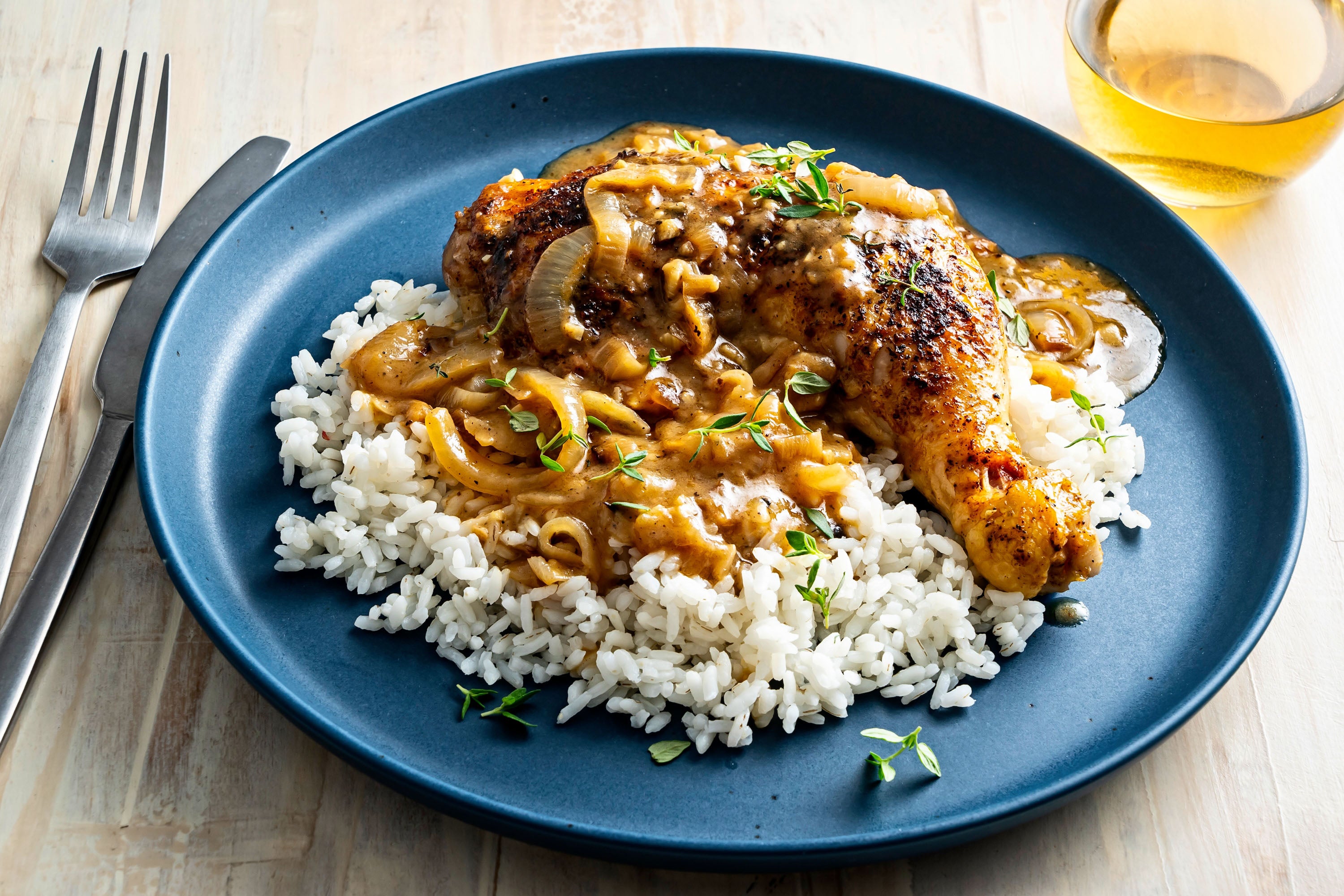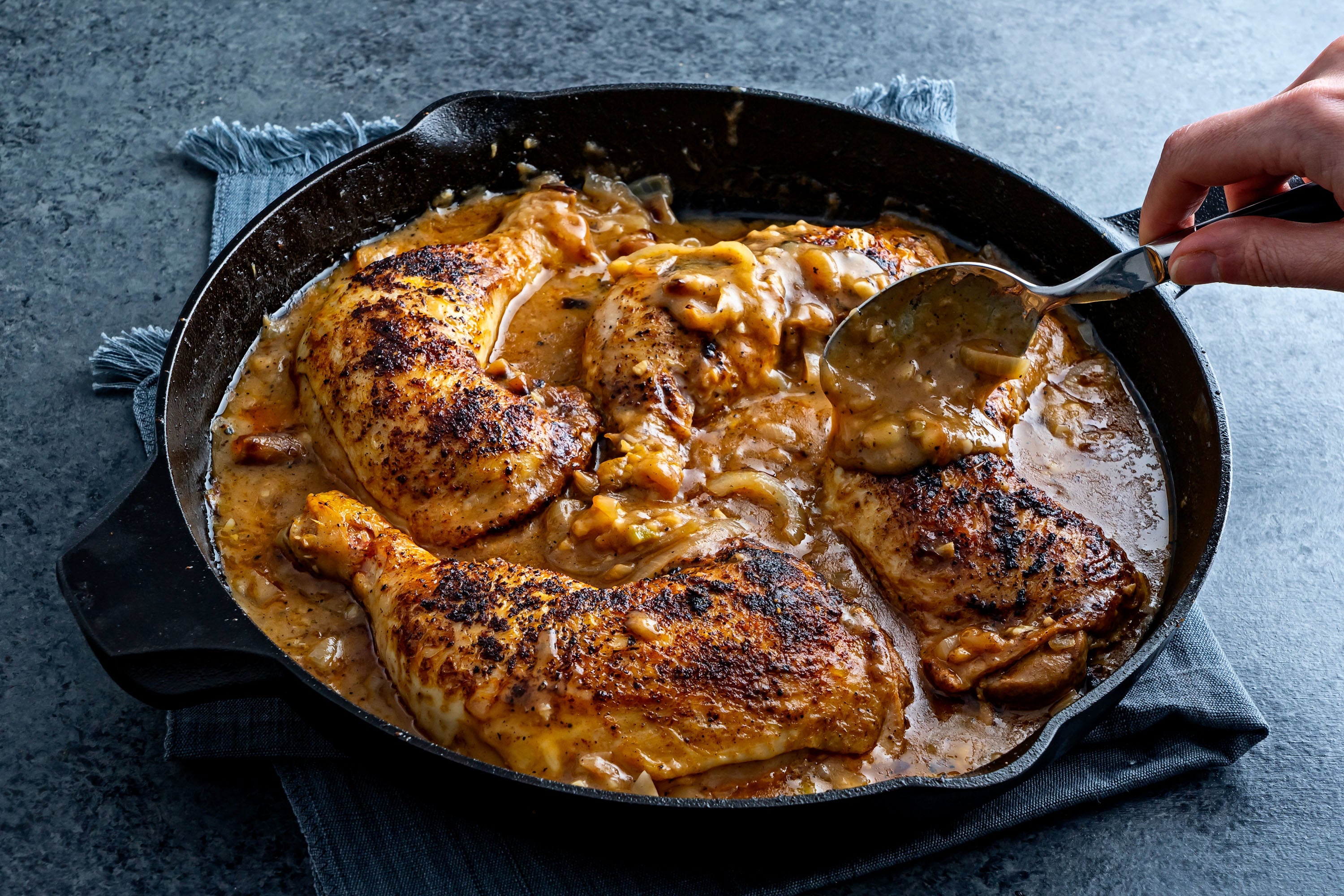Smothered chicken: The quintessential soul food recipe you need to know
Follow Aaron Hutcherson’s recipe for what he considers to be a classic version of the dish, or use it as a jumping off point to create your own

Your support helps us to tell the story
This election is still a dead heat, according to most polls. In a fight with such wafer-thin margins, we need reporters on the ground talking to the people Trump and Harris are courting. Your support allows us to keep sending journalists to the story.
The Independent is trusted by 27 million Americans from across the entire political spectrum every month. Unlike many other quality news outlets, we choose not to lock you out of our reporting and analysis with paywalls. But quality journalism must still be paid for.
Help us keep bring these critical stories to light. Your support makes all the difference.
The word “smothering” doesn’t always have the best connotation (see: relationships or preventing someone from breathing). But when it comes to cooking, it’s something I crave when in need of solace. Basically a stovetop braise, smothering is a technique most often associated with chicken or pork – but can be used with other types of animal proteins as well as vegetables – where the braising liquid is thickened to form a luscious gravy. And that gravy is the true star of the dish.
“The gravy could be a meal on its own if you do it right,” chef and cookbook author Adrienne Cheatham says.
Smothering’s exact origins are unknown. The earliest reference I found in print is a recipe “To Smother Young Chickens” in Lettice Bryan’s The Kentucky Housewife, originally published in 1839. Some attribute it to Louisiana’s Cajun and Creole cuisines, where “étouffée” translates to “smothered”. In South Carolina’s Lowcountry, “stew chicken” is nearly identical to what others know as “smothered chicken”. I consider it a quintessential soul food dish and a staple of Southern cuisine at large, and regardless of what you call it or where it’s from, this much is certain: the dish is full of comfort.
I tend to think of the dish more as a technique than an exact recipe, as each individual has their own preferences for the cut of chicken to use, whether it is dredged in flour before browning, which vegetables to include, and more. Follow my recipe below for what I consider to be a classic version of the dish, or use the steps that follow as a jumping off point to create your own smothered chicken.
Step 1: Season and brown the chicken. Growing up, I remember my mother frequently buying packages of whole, cut-up chickens to cook with, but I would caution against that today. While, technically speaking, you can use whatever cut of chicken you have on hand, “You really want to use bone-in dark meat, preferably thighs or thigh and leg quarters,” Cheatham says. With chicken breasts – “Blasphemy!” Cheatham exclaims – you’ll need to reduce the cooking time compared to dark meat, and as a result, you won’t get the same depth of flavour.
To season the chicken, I opt for garlic powder and smoked paprika (in addition to salt and pepper) in the recipe below. Cheatham is a fan of celery seed powder. You can use your favourite shop-bought spice blend or create your own.
Another point of contention is whether to dredge the chicken pieces in flour before searing. The smothered chicken I remember eating in my youth was basically fried chicken with gravy. While the flour coating gives the gravy something to really hold onto, I wanted to limit the amount of oil that would otherwise be required. Eliminating this step streamlines the recipe without much change in the result. Not dredging also means you can render the fat from the chicken as it browns, thus reducing the need for additional oil even further.
Step 2: Saute the vegetables. Once the chicken is browned and set to the side, vegetables are added to the pan to form the base of the gravy. I like the simplicity of onion and garlic. The two sides of Cheatham’s family used either the “trinity” (onions, celery and green bell pepper) or onions, celery and mushrooms. She prefers the trinity, but is not beholden to it, and will use various vegetables she has on hand.
Step 3: Build a roux. After the vegetables have cooked down some, sprinkle them with flour before adding liquid to form the gravy. I like my gravy full bodied, so I call for more flour than some recipes, but you can reduce it if you prefer a thinner consistency. And while all-purpose flour certainly gets the job done, Cheatham recommends Wondra, a type of instant flour that dissolves easily, eliminating any worry about lumps.
Step 4: Add liquid and braise the chicken. “I’ll usually deglaze with wine or beer,” Cheatham says. “Honestly, I’ll use whatever I have in the fridge or that’s open already.” I like the crisp acidity of a white wine such as pinot grigio for scraping up the brown bits on the bottom of the pan. Then stock or water compose the remainder of the braising liquid. For a creamier gravy, add some form of dairy or stir in a tin of cream of mushroom or chicken soup. A couple sprigs of thyme help flavour the braising liquid in the recipe below. Sage and bay leaves are also common, but soy sauce, Dijon mustard or Worcestershire sauce can add extra pizazz. Lastly, let it simmer on the stovetop until the chicken is tender and the gravy is full of flavour (though you could also braise it in the oven, if you wish).
There are as many iterations of smothered chicken as there are cooks, and you can’t go wrong once you have the basic steps and fundamentals down. However, one thing just about everyone will agree on is that it’s always a good idea to serve it with rice to sop up the gravy.

Smothered chicken
Active time: 45 minutes | Total time: 1 hour 15 minutes
Serves: 4 to 6
Smothered chicken is a traditional Southern dish where chicken parts are braised with aromatics and liquid to form a luscious gravy. There are as many ways to prepare it as there are cooks, so feel free to use this recipe as a template for your own creation. The finished dish is commonly served with rice to sop up the gravy.
Ingredients:
2 tbsp vegetable oil
1¼ tsp fine salt, divided, plus more to taste
1 tsp ground black pepper, plus more to taste
½ tsp garlic powder
½ tsp smoked paprika
1.4kg chicken leg quarters, patted dry (can substitute thighs and/or drumsticks) (see notes below)
2 medium yellow onions (about 400g), halved and thinly sliced
3 to 4 cloves garlic, minced or finely grated
3 tbsp all-purpose flour
120ml dry white wine, such as pinot grigio (see notes)
240ml unsalted or low-sodium chicken stock
2 to 3 sprigs fresh thyme
Method:
In a large frying pan over medium heat, heat the oil until shimmering. Meanwhile, in a small bowl, mix 1 teaspoon of salt, the pepper, garlic powder and paprika until combined. Sprinkle the seasoning mixture all over the chicken.
Working in batches, if needed, so as to not overcrowd the pan, place the chicken in the pan, skin side down, and sear until nicely browned, 5 to 8 minutes. Flip the chicken and cook on the other side until browned, about 5 minutes. Transfer the chicken to a platter or rimmed baking tray. Repeat with the remaining chicken, if needed.
Add the onions and the remaining ¼ teaspoon of salt to the pan and cook, stirring occasionally, until they start to brown, about 8 minutes. Add the garlic and cook, stirring regularly, until fragrant, about 1 minute. Sprinkle the flour over the onions and cook, stirring regularly, until lightly browned, about 2 minutes.
Add the wine, scraping up any stuck-on bits from the bottom of the pan. Add the stock and thyme, stir to combine and bring to a simmer. Return the chicken and any accumulated juices to the pan, partially cover, and cook, adjusting the heat as necessary to maintain a gentle simmer, until the chicken is fully cooked (an instant-read thermometer should register at least 75C when inserted into the thickest part of the chicken without touching the bone) and tender, about 30 minutes. Taste, and season with salt and/or pepper, as desired. Discard thyme sprigs and serve (see notes).
Notes:
If avoiding alcohol, use an equal amount of additional chicken stock and a splash of vinegar in place of the wine.
If using leg quarters, you can cut each quarter into thighs and drumsticks for more servings.
How to store: Refrigerate leftovers for up to 3 days.
Nutrition information per serving, based on 6 | calories: 482; total fat: 32g; saturated fat: 8g; cholesterol: 151mg; sodium: 655mg; carbohydrates: 11g; dietary fibre: 2g; sugar: 3g; protein: 33g.
This analysis is an estimate based on available ingredients and this preparation. It should not substitute for a dietitian’s or nutritionist’s advice.
© The Washington Post
Join our commenting forum
Join thought-provoking conversations, follow other Independent readers and see their replies
Comments